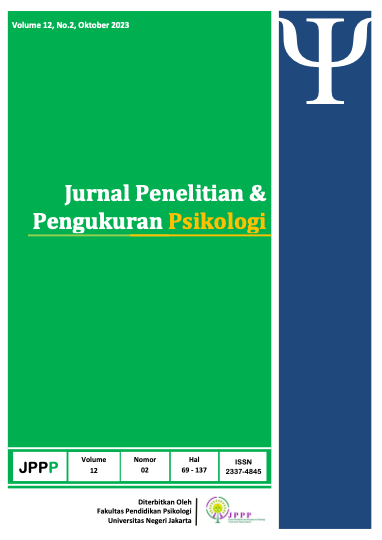Evaluation of Psychometric Characteristics of A Logical Reasoning Tool With The Classic Test Theory Approach
DOI:
https://doi.org/10.21009/JPPP.122.02Keywords:
Evaluation, Classical theory, Logical reasoning measurement, Psychometric characteristics, StudentsAbstract
Research on logical reasoning began to be carried out in Indonesia, it is necessary to conduct an evaluation of the psychometric characteristics possessed by logical reasoning measurement tools made by researchers. Logical reasoning measurement tools made by researchers need to be re-evaluated considering there are weaknesses in terms of using a relatively small number of subjects, so that it can affect the standardization of logical reasoning measuring devices. This study aims to obtain an overview of item difficulty index, item discrimination index, effectiveness of the distractors, validity, reliability, and error measurement from the logical reasoning measurement tool. Respondents in this study amounted to 7.730 students, consisting of 3.897 men and 3.833 women with an age range of 15-19 years. The research data were analyzed with the help of Microsoft Excel 2007, SPSS version 22.00, and ITEMAN version 3.6. The results of this study indicate that the item difficulty index moves from 0.35 to 0.80 which belongs to the easy and medium category. This study also shows that the item discrimination index moves from 0.10 to 0.71 with four items rejected and need to be aborted. This study also shows that the effectiveness of the distractors contained in each item in the logical reasoning measure is in the effective category. This study also shows that each item in the logical reasoning measure is considered valid in terms of factorial validity through exploratory factor analysis (EFA) procedures. This study also shows that the measurement of logical reasoning is relatively reliable with a Cronbach Alpha coefficient of 0.906. This study also shows that the measurement error obtained in this study is ± 3.92 of the total score obtained using a logical reasoning measure with a confidence level of 95%, with the actual score estimate obtained by respondents moving from 12.08 to 19.92, if the scores obtained by respondents sixteen.
References
Azwar, S. (2012). Reliabilitas dan validitas. Yogyakarta: Pustaka Pelajar.
Azwar, S. (2015a). Dasar-dasar psikometrika edisi 2 cetakan I. Yogyakarta: Pustaka Pelajar.
Azwar, S. (2015b). Tes prestasi: Fungsi dan pengembangan pengukuran prestasi belajar. Yogyakarta: Pustaka Pelajar.
Azwar, S. (2016). Konstruksi tes kemampuan kognitif edisi 1. Yogyakarta: Pustaka Pelajar.
Bancong, H., & Subaer. (2013). Profil penalaran logis berdasarkan gaya berpikir dalam memecahkan masalah fisika peserta didik. Jurnal Pendidikan IPA Indonesia, 2(2), 195-202. https://doi.org/10.15294/jpii.v2i2.2723
Coaley, K. (2010). An introduction to psychological assessment and psychometrics. London: SAGE Publications.
Dedy, G. N. R., & Paryanto. (2015). New test TPA/PAPS OTO Bappenas. Yogyakarta: Forum Edukasi.
Fauziah, L. U., Hobri., Oktavianingtyas, E. (2016). Penalaran logis dalam memecahkan masalah matematika pokok bahasan aritmatika sosial pada siswa kelas VII SMP Negeri 4 Jember. Jurnal Edukasi, 3(1), 15-17. https://doi.org/10.19184/jukasi.v3i1.4314
Gregory, R. J. (2013). Tes psikologi: Sejarah, prinsip, dan aplikasinya. Jakarta: Erlangga.
Hair J. F., Black, W. C., Babin, B. J., & Anderson R. E. (2014). Multivariate data analysis (7th. Ed.). London: Pearson Education Limited.
Hartono. (2015). Analisis item instrumen cetakan I. Pekanbaru Riau: Zanafa Publishing.
Jalaluddin. (2014). Filsafat ilmu pengetahuan: Filsafat, ilmu pengetahuan, dan peradaban. Jakarta: Rajawali Pers.
Kaplan, R. M., & Saccuzzo, D. P. (2012). Pengukuran psikologi: Prinsip, penerapan, dan isu edisi 7. Terjemahan oleh E. P. Widodo. Jakarta: Salemba Humanika.
Lanani, K. (2015). Efektivitas pembelajaran kooperatif ditinjau dari peningkatan kemampuan penalaran logis matematis siswa. Jurnal Ilmiah Program Studi Matematika STKIP Siliwangi Bandung, 4(2), 140-151. https://doi.org/10.22460/infinity.v4i2.p140-151
Marwanta., Suprijanto, S., Murniati, S., Herynugroho., Sajaka, K. A., & Soetiyono. (2009). Mathematics for senior high school year X. Jakarta: Yudhistira.
Noormandiri. (2004). Matematika untuk SMA kelas X. Jakarta: Erlangga.
Nugraha, D. Y. (2017). Laporan konstruksi alat ukur psikologi (Alat ukur penalaran logis). Tugas Akhir Mata Kuliah Konstruksi Alat Ukur Psikologi tidak diterbitkan. Makassar: Program Studi Psikologi Fakultas Psikologi Universitas Negeri Makassar.
Riswanto, I. (2013). Pengembangan soal tes potensi akademik numerik penerimaan siswa baru SMP berbantuan media berbasis wireless application protocol java 2 micro edition (J2ME). Jurnal Pancaran, 2(1), 95-104. https://jurnal.unej.ac.id/index.php/pancaran/article/view/665
Setiawati, F. A., Izzaty, R. E., & Hidayat, V. (2018). Evaluasi karakteristik psikometrik tes bakat differensial dengan teori klasik. Jurnal Humanitas, 15(1), 46-61. http://dx.doi.org/10.26555/humanitas.v15i1.7249
Suryabrata, S. (2005). Pengembangan alat ukur psikologis edisi 3. Yogyakarta: ANDI.
Upu, H. (2015). English for basic mathematics. Makassar: Pustaka Refleksi.
Usdiyana, D., Purniati, T., Yulianti, K., & Harningsih, E. (2009). Meningkatkan kemampuan berpikir logis siswa SMP melalui pembelajaran matematika realistik. Jurnal Pengajaran MIPA, 13(1), 1-14. https://doi.org/10.18269/jpmipa.v13i1.35779
Wardana, A. (2007). Modul metode penelitian sosial budaya (Menggunakan SPSS dalam penelitian sosial). Yogyakarta: Program Studi Pendidikan Sosiologi Jurusan Pendidikan Sejarah Fakultas Ilmu Sosial dan Ekonomi Universitas Negeri Yogyakarta.
Wirodikromo, S. (2006). Matematika untuk SMA kelas X. Jakarta: Erlangga.
Woodhouse, M. B. (2000). Berfilsafat: Sebuah langkah awal. Yogyakarta: Kanisus.







